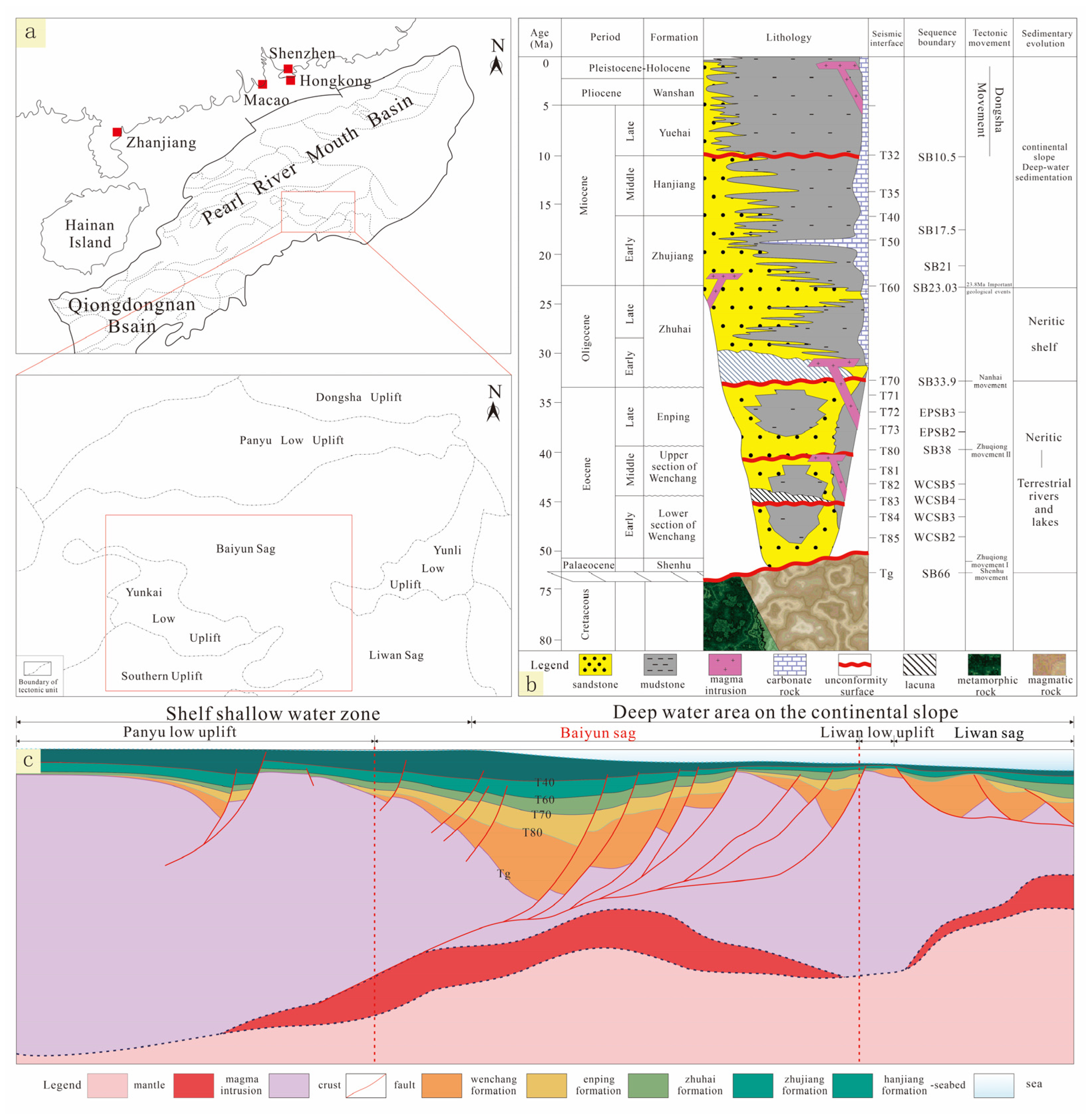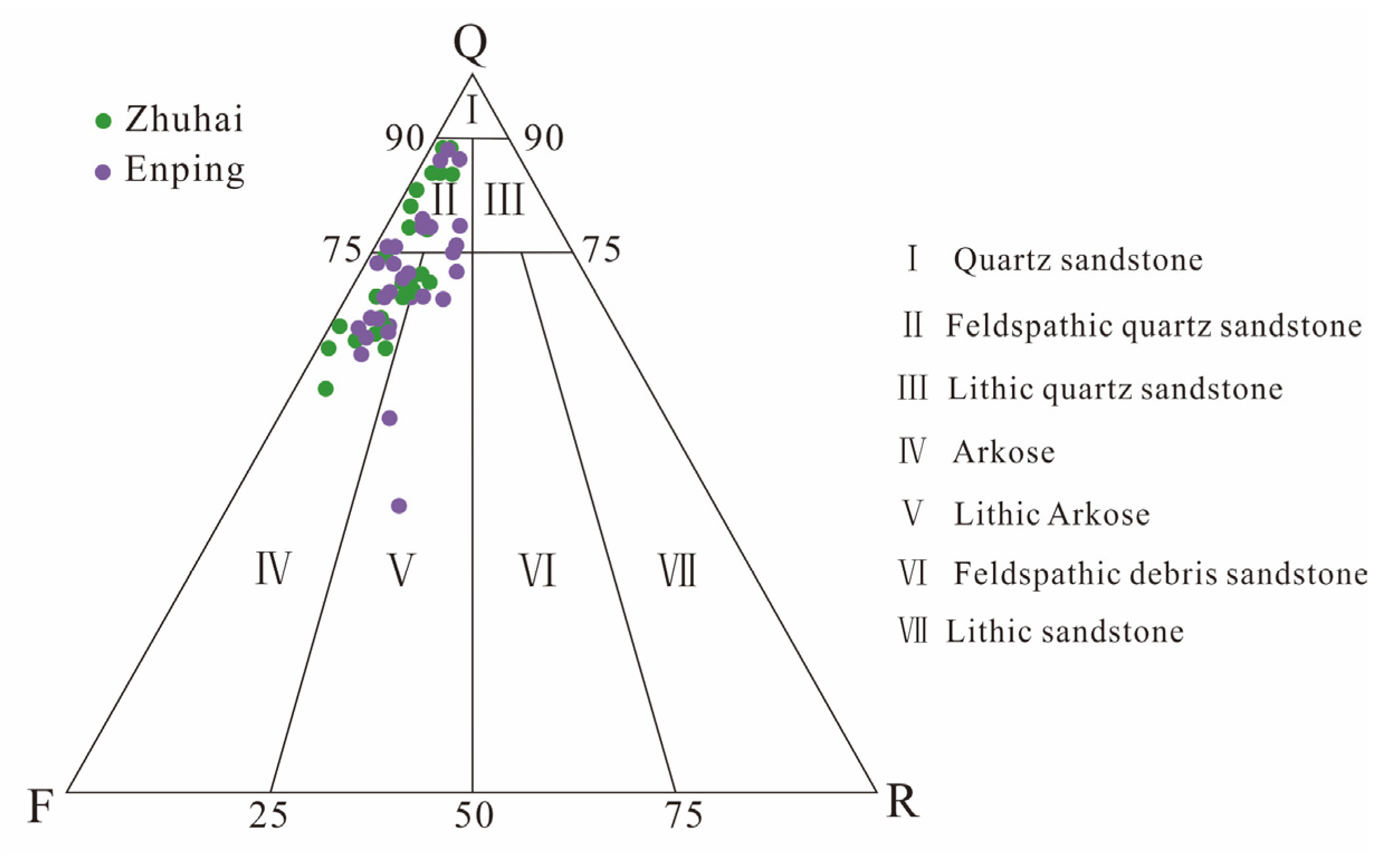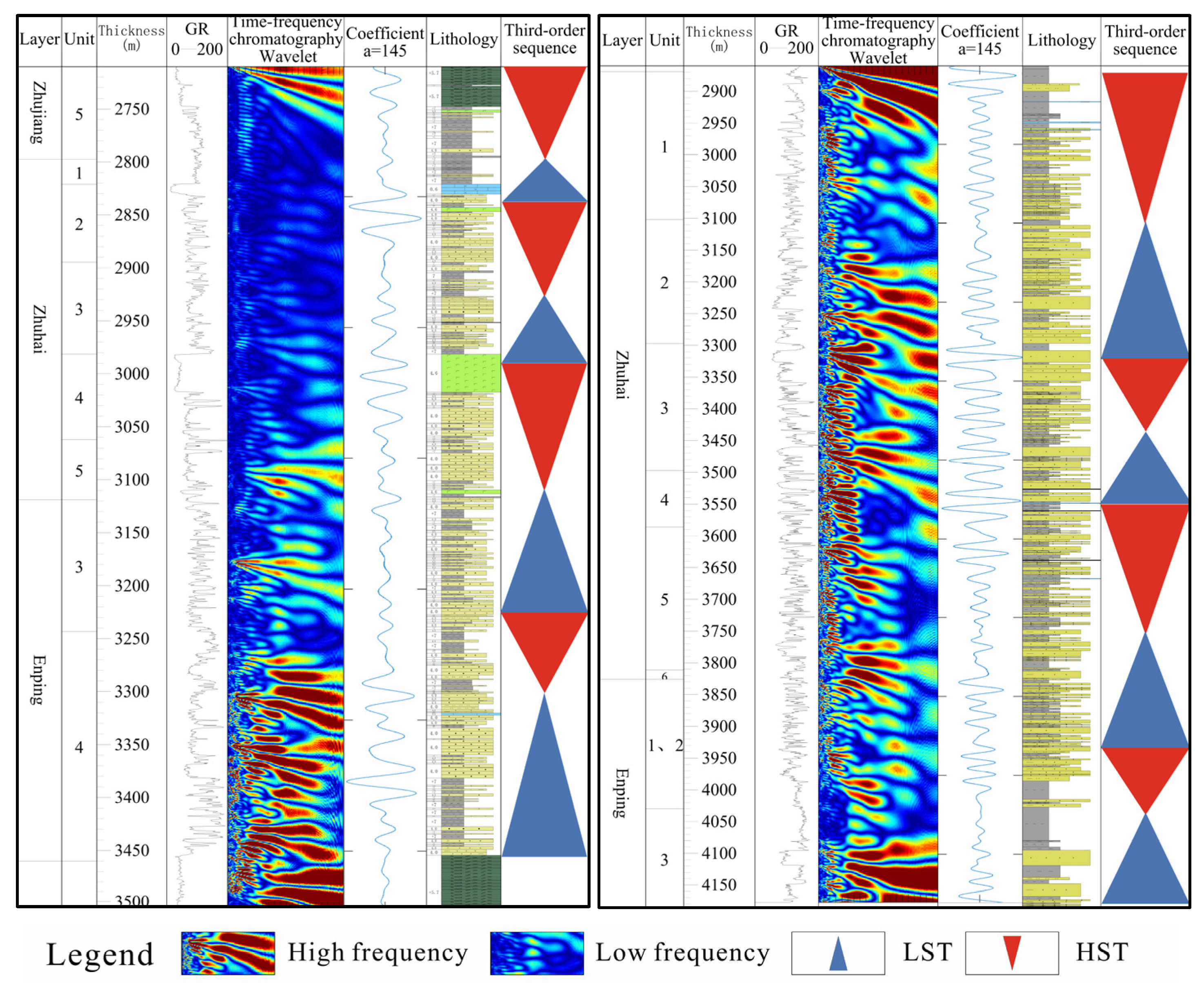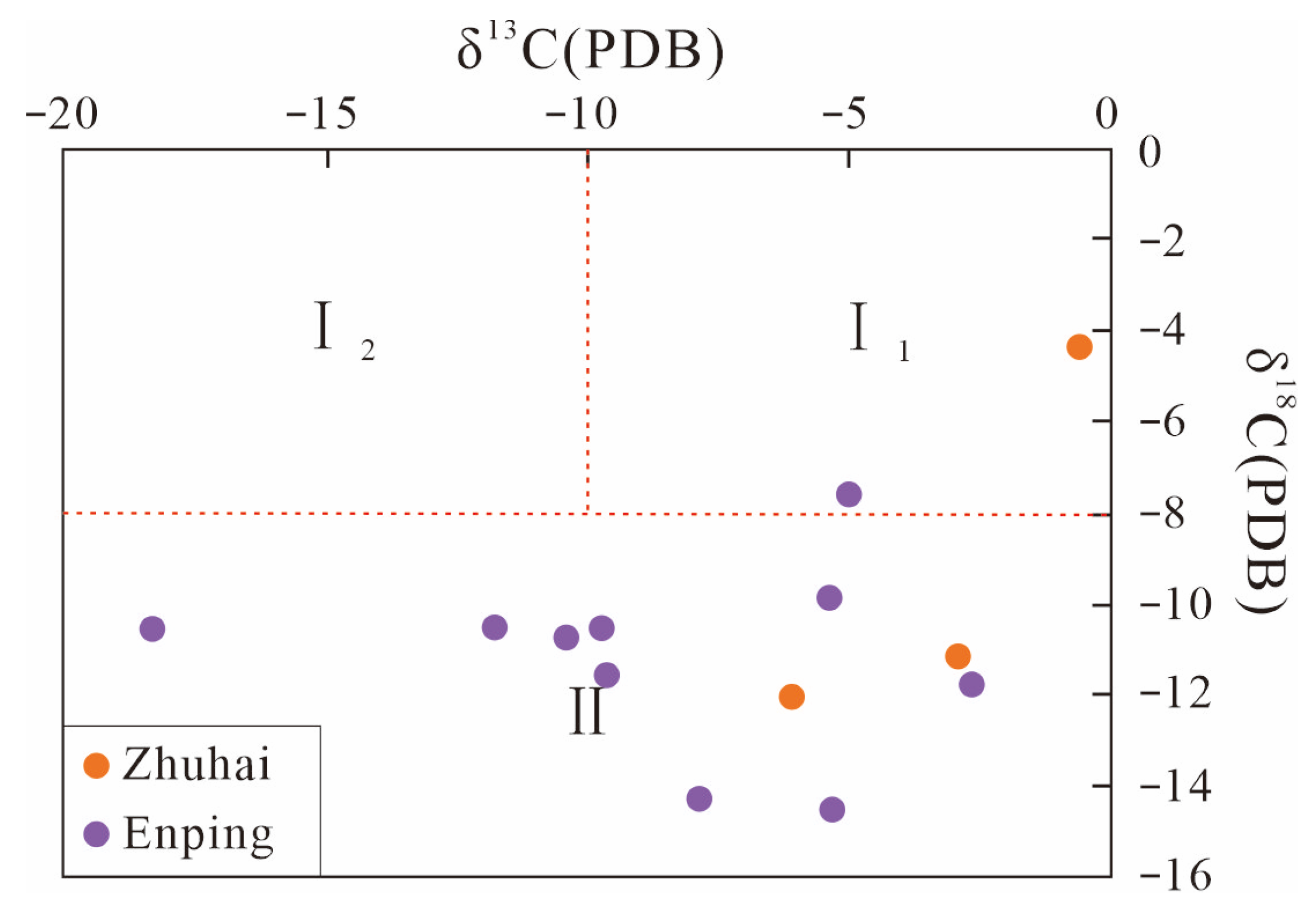Diagenetic Evolution and Petrophysical Characteristics of Paleogene Sandstone Reservoirs in the Southwest Baiyun Sag, Northern South China Sea
Abstract
:1. Introduction
2. Geological Setting
2.1. Basin Evolution

2.2. Stratigraphy and Depositional Facies
3. Materials and Methods
4. Results
4.1. Petrology Characteristics
4.2. Reservoir Physical Properties
4.3. Wavelet Analysis
4.4. Seismic Facies Analysis
4.5. Diagenesis Type of the Reservoirs
4.5.1. Compaction
4.5.2. Cementation
4.5.3. Dissolution
5. Discussion
5.1. Diagenetic Environment and Stages
5.2. Diagenetic Sequence
5.3. Pore Evolution Characteristics
5.4. The Impact of Diagenetic Evolution on Reservoirs
- (1)
- Mainly Mechanical Compaction: This type is primarily observed in the Zhuhai Formation at burial depths exceeding 2300 m, with diagenesis temperatures ranging from 72 to 90 °C. In the early diagenetic stage, the sandstone grains are loose, and primary pores are well-preserved. However, as the burial depth increases, the grain arrangement becomes progressively tighter, and primary pores are filled with authigenic clay minerals, leading to the densification of the reservoir. Unstable clastic grains, such as feldspars, are prone to dissolution, and some rigid grains may fracture. This diagenetic evolution results in poor reservoir performance.
- (2)
- Unstable Clastic Dissolution Dominant: This type is mainly found in the Zhuhai Formation and the upper part of the Enping Formation, at burial depths of 2300 to 3500 m, with diagenesis temperatures ranging from 70 to 95 °C. Reservoirs with larger particle diameters, better sorting, and higher pore permeability are observed. There is less compaction, and primary pores are well-preserved. Intense dissolution enhances the physical properties of the reservoir, with loose sandstone grains having a higher content of matrix and plastic debris. The main rock-forming minerals, such as calcite and kaolinite, are associated with feldspar dissolution. However, they fill only a small proportion of the pores in the reservoir, with them having little effect on porosity and permeability.
- (3)
- Dominated by Carbonate Rocks Cemented with Clay Minerals: This type is more developed in the lower part of the Enping Formation, at burial depths exceeding 3500 m, with diagenesis temperatures ranging from 120 to 146 °C. The diagenetic evolution is mainly characterized by carbonate rocks cemented with clay minerals, with pore fills dominated by calcite, ferrocalcite, kaolinite, and illite. Secondary dissolution pores are minimal, with only a few remaining primary pores and feldspar dissolution pores as the main reservoir space. As most primary pores are filled by cement and the degree of dissolution is low, the storage space is limited, resulting in relatively poor pore permeability in reservoirs of this type of diagenetic evolution.
6. Conclusions
- (1)
- The Paleogene sandstones within the Baiyun Sag predominantly comprise feldspathic quartz sandstones and feldspathic sandstones. The reservoirs exhibit a predominance of secondary porosity, complemented by a minor presence of fractures. In the Zhuhai Formation and the upper segment of the Enping Formation reservoirs, intergranular dissolution pores dominate, followed by intragranular dissolution pores, contributing to higher permeability. Conversely, the lower segment of the Enping Formation reservoirs primarily exhibits intragranular dissolved pores, with relatively well-developed micropores resulting in lower permeability.
- (2)
- At greater depths, reservoir porosity exhibits a clear declining trend. Remarkably, a secondary pore development zone emerges at 2280–2350 m, characterized primarily by intergranular dissolution pores and intragranular dissolution pores. This unique zone is a consequence of the diverse impact of diagenetic processes on the reservoir physical properties.
- (3)
- Seismic signatures of the Zhuhai and Enping formations are classified into four third-order sequences. Carbonate cement in the upper Zhuhai Formation originated from a mixed-water diagenetic environment, while the lower Zhuhai Formation and Enping Formation sandstone reservoirs underwent freshwater diagenesis. The diagenetic temperatures ranged from 42.6 to 116.3 °C. Sandstones of the upper Zhuhai Formation correspond to Early Diagenesis Stage B, while the lower Zhuhai Formation and Enping Formation correspond to Middle Diagenesis Stage A.
- (4)
- In the deepwater area of the Baiyun Sag, sandstone reservoirs have undergone three main diagenetic evolution processes: compaction leading to a reduction in porosity of 23.07%, cementation leading to a reduction of 9.02%, and dissolution enhancing porosity leading to a reduction of 5.09%. The diagenetic evolution is characterized by mechanical compaction, carbonate cementation, and feldspar dissolution. Notably, feldspar dissolution contributes to the formation of high-quality reservoirs, making the sandstone in the upper part of the Enping Formation a conventional high-quality reservoir.
Author Contributions
Funding
Data Availability Statement
Acknowledgments
Conflicts of Interest
References
- Zhang, G.C.; Yang, H.Z.; Chen, Y.; Ji, M.; Wang, K.; Yang, D.S.; Han, Y.X.; Sun, Y. The Baiyun Sag: A giant rich gas-generation sag in the deepwater area of the Pearl River Mouth Basin. Nat. Gas Ind. 2014, 34, 11–25. [Google Scholar]
- Han, J.; Xu, G.; Li, Y.; Zhuo, H. Evolutionary history and controlling factors of the shelf breaks in the Pearl River Mouth Basin, northern South China Sea. Mar. Pet. Geol. 2016, 77, 179–189. [Google Scholar] [CrossRef]
- Xiao, X.M.; Li, N.X.; Gan, H.J.; Jin, Y.B.; Tian, H.; Huang, B.J.; Tang, Y.C. Tracing of deeply-buried source rock: A case study of the WC9-2 petroleum pool in the Pearl River Mouth Basin, South China Sea. Mar. Pet. Geol. 2009, 26, 1365–1378. [Google Scholar] [CrossRef]
- Yu, X.; Wang, J.; Liang, J.; Li, S.; Zeng, X.; Li, W. Depositional characteristics and accumulation model of gas hydrates in northern South China Sea. Mar. Pet. Geol. 2014, 56, 74–86. [Google Scholar] [CrossRef]
- Wang, W.; Yang, X.; Bidgoli, T.S.; Ye, J. Detrital zircon geochronology reveals source-to-sink relationships in the Pearl River Mouth Basin, China. Sediment. Geol. 2019, 388, 81–98. [Google Scholar] [CrossRef]
- Jiang, Z.; Du, H.; Li, Y.; Zhang, Y.; Huang, Y. Simulation of Gas Generation from the Paleogene Enping Formation in the Baiyun Sag in the Deepwater Area of the Pearl River Mouth Basin, the South China Sea. Energy Fuels 2015, 29, 577–586. [Google Scholar] [CrossRef]
- Shi, C.; Long, Z.; Zhu, J.; Jiang, Z.; Huang, Y. Element geochemistry of the Enping Formation in the Baiyun Sag of Pearl River Mouth Basin and their environmental implications. Mar. Geol. Quat. Geol. 2020, 40, 79–86. [Google Scholar]
- Zeng, Z.; Zhu, H.; Mei, L.; Du, J.; Zeng, H.; Xu, X.; Dong, X. Multilevel source-to-sink (S2S) subdivision and application of an ancient uplift system in South China Sea: Implications for further hydrocarbon exploration. J. Pet. Sci. Eng. 2019, 181, 106220. [Google Scholar] [CrossRef]
- Ma, B.; Gao, J.; Eriksson, K.A.; Zhu, H.; Liu, Q.; Ping, X.; Zhang, Y. Diagenetic alterations in Eocene, deeply buried volcaniclastic sandstones with implications for reservoir quality in the Huizhou depression, Pearl River Mouth Basin, China. Aapg Bull. 2023, 107, 929–955. [Google Scholar] [CrossRef]
- Li, C.; Luo, J.L.; Hu, H.Y.; Chen, S.; Wang, D.; Liu, B.; Ma, Y.; Chen, L.; Li, X. Thermodynamic Impact on Deepwater Sandstone Diagenetic Evolution of Zhuhai Formation in Baiyun Sag, Pearl River Mouth Basin. Earth Sci. 2019, 44, 572–587. [Google Scholar]
- Zhuo, H.; Wang, Y.; Sun, Z.; Wang, Y.; Xu, Q.; Hou, P.; Wang, X.; Zhao, Z.; Zhou, W.; Xu, S. Along-strike variability in shelf-margin morphology and accretion pattern: An example from the northern margin of the South China Sea. Basin Res. 2019, 31, 431–460. [Google Scholar] [CrossRef]
- Zeng, Z.; Zhu, H.; Yang, X.; Zhang, G.; Zeng, H. Three-dimensional imaging of Miocene volcanic effusive and conduit facies: Implications for the magmatism and seafloor spreading of the South China Sea. Mar. Pet. Geol. 2019, 109, 193–207. [Google Scholar] [CrossRef]
- Gao, N.; Lin, C.; Eriksson, K.; Zhang, Z.; Gao, D.; Zhang, B.; Shu, L.; Wei, A. Sequence architecture and depositional evolution of Eocene to Oligocene, synrift to early postrift strata in the Baiyun Sag, South China Sea. Interpret.-A J. Subsurf. Charact. 2019, 7, T309–T329. [Google Scholar] [CrossRef]
- Ma, M.; Chen, G.J.; Li, C. Quantitative analysis of porosity evolution and formation mechanism of good reservoir in Enping Formation, Baiyun Sag, Pearl River Mouth Basin. Nat. Gas Geosci. 2017, 28, 1515–1526. [Google Scholar]
- Peng, J.W.; Pang, X.Q.; Peng, H.J.; Ma, X.X.; Shi, H.S.; Zhao, Z.F.; Xiao, S.; Zhu, J.Z. Geochemistry, origin, and accumulation of petroleum in the Eocene Wenchang Formation reservoirs in Pearl River Mouth Basin, South China Sea: A case study of HZ25-7 oil Field. Mar. Pet. Geol. 2017, 80, 154–170. [Google Scholar] [CrossRef]
- Gong, C.; Wang, Y.; Zheng, R.; Hernández-Molina, F.J.; Li, Y.; Stow, D.; Xu, Q.; Brackenridge, R.E. Middle Miocene reworked turbidites in the Baiyun Sag of the Pearl River Mouth Basin, northern South China Sea margin: Processes, genesis, and implications. J. Asian Earth Sci. 2016, 128, 116–129. [Google Scholar] [CrossRef]
- Wang, D.F.; Luo, J.L.; Chen, S.H.; Haiyan, H.U.; Yongkun, M.A.; Chi, L.I. Carbonate Cementation and Origin Analysis of Deep Sandstone Reservoirs in the Baiyun Sag, Pearl River Mouth Basin. Acta Geol. Sin. 2017, 91, 2079–2090. [Google Scholar]
- Xu, S.H.; Wang, Y.M.; Xu, G.Q.; Zeng, G.D.; Guo, W.; Gong, C.L.; Cai, C.E.; Tang, W.; Zhuo, H.T.; Wan, H.Q. Linking shelf delta to deep-marine deposition in reservoir dispersal of the upper Oligocene strata in the Baiyun Sag, the northern South China Sea. Aust. J. Earth Sci. 2015, 62, 365–382. [Google Scholar]
- Wen, J.; Zhao, J.; Li, J.; Er, C. Characteristics of Mid-Deep Paleogene Sandstone Reservoirs in Baiyun Sag and Controlling Effect of Dissolution on High-Quality Reservoirs. Spec. Oil Gas Reserv. 2022, 29, 47–55. [Google Scholar]
- Wu, Y.; Ding, W.; Clift, P.D.; Li, J.; Yin, S.; Fang, Y.; Ding, H. Sedimentary budget of the Northwest Sub-basin, South China Sea: Controlling factors and geological implications. Int. Geol. Rev. 2020, 62, 970–987. [Google Scholar] [CrossRef]
- Yang, L.; Ren, J.; McIntosh, K.; Pang, X.; Lei, C.; Zhao, Y. The structure and evolution of deepwater basins in the distal margin of the northern South China Sea and their implications for the formation of the continental margin. Mar. Pet. Geol. 2018, 92, 234–254. [Google Scholar] [CrossRef]
- Clift, P.D.; Brune, S.; Quinteros, J. Climate changes control offshore crustal structure at South China Sea continental margin. Earth Planet. Sci. Lett. 2015, 420, 66–72. [Google Scholar] [CrossRef]
- Ji, M.; Yang, H.; Zeng, Q.; Zhao, Z.; Wang, L.; Sun, Y. Structural analysis and its petroleum significance of detachment faults in Baiyun Sag, Pearl River Mouth Basin. Nat. Gas Geosci. 2017, 28, 1506–1514. [Google Scholar]
- Zhou, Z.; Mei, L.; Liu, J.; Zheng, J.; Chen, L.; Hao, S. Continentward-dipping detachment fault system and asymmetric rift structure of the Baiyun Sag, northern South China Sea. Tectonophysics 2018, 726, 121–136. [Google Scholar] [CrossRef]
- Longtao, S.U.N.; Di, Z.; Changmin, C.; Wenhuan, Z.; Zhen, S.U.N. Fault structure and evolution of Baiyun Sag in Zhujiang River Mouth Basin. J. Trop. Oceanogr. 2008, 27, 25–31. [Google Scholar]
- Pang, X.; Zheng, J.; Ren, J.; Wang, F.; Yan, H.; Sun, H.; Liu, B. Structural Evolution and Magmatism of Fault Depression in Baiyun Sag, Northern Margin of South China Sea. Earth Sci. 2022, 47, 2303–2316. [Google Scholar]
- Zhou, W.; Zhuo, H.; Wang, Y.; Xu, Q.; Li, D. Post-rift submarine volcanic complexes and fault activities in the Baiyun Sag, Pearl River Mouth Basin: New insights into the breakup sequence of the northern South China Sea. Mar. Geol. 2020, 430, 106338. [Google Scholar] [CrossRef]
- Wang, W.; Zeng, Z.; Yang, X.; Bidgoli, T. Exploring the roles of sediment provenance and igneous activity on the development of synrift lacustrine source rocks, Pearl River Mouth Basin, northern South China Sea. Mar. Petroleum Geol. 2023, 147, 105990. [Google Scholar] [CrossRef]
- Ye, Q.; Mei, L.; Shi, H.; Shu, Y.; Camanni, G.; Wu, J. A low-angle normal fault and basement structures within the Enping Sag, Pearl River Mouth Basin: Insights into late Mesozoic to early Cenozoic tectonic evolution of the South China Sea area. Tectonophysics 2018, 731, 1–16. [Google Scholar] [CrossRef]
- Ge, J.W.; Zhu, X.M.; Zhang, X.T.; Jones, B.G.; Yu, F.S.; Niu, Z.C.; Li, M. Tectono-stratigraphic evolution and hydrocarbon exploration in the Eocene Southern Lufeng Depression, Pearl River Mouth Basin, South China Sea. Aust. J. Earth Sci. 2017, 64, 931–956. [Google Scholar] [CrossRef]
- Pang, X.; Ren, J.; Zheng, J.; Liu, J.; Yu, P.; Liu, B. Petroleum geology controlled by extensive detachment thinning of continental margin crust: A case study of Baiyun sag in the deep-water area of northern South China Sea. Pet. Explor. Dev. 2018, 45, 29–42. [Google Scholar] [CrossRef]
- Cheng, P.; Tian, H.; Huang, B.J.; Wilkins, R.W.T.; Xiao, X.M. Tracing early-charged oils and exploration directions for the Wenchang A sag, western Pearl River Mouth Basin, offshore South China Sea. Org. Geochem. 2013, 61, 15–26. [Google Scholar] [CrossRef]
- Robison, C.R.; Elrod, L.W.; Bissada, K.K. Petroleum generation, migration, and entrapment in the Zhu 1 depression, Pearl River Mouth basin, South China Sea. Int. J. Coal Geol. 1998, 37, 155–178. [Google Scholar] [CrossRef]
- Wu, X.; Zhou, D.; Pang, X.; Hao, H.; Shen, J. Geophysical Field and Deep Structures of Baiyun Sag, Zhujiang River Mouth Basin. J. Trop. Oceanogr. 2005, 24, 62–69. [Google Scholar]
- Zeng, Z.; Zhu, H.; Yang, X.; Zeng, H.; Zhang, G. Multistage progradational clinoform-set characterisation and evolution analysis of the Early Oligocene in the Baiyun Sag, Pearl River Mouth Basin, South China Sea. Mar. Pet. Geol. 2020, 112, 104048. [Google Scholar] [CrossRef]
- Kong, L.; Chen, H.; Ping, H.; Zhai, P.; Liu, Y.; Zhu, J. Formation pressure modeling in the Baiyun Sag, northern South China Sea: Implications for petroleum exploration in deep-water areas. Mar. Pet. Geol. 2018, 97, 154–168. [Google Scholar] [CrossRef]
- Tian, B.; Zheng, Y.; Zhao, J. Sedimentary facies and evolution of Oligocene Zhuhai Formation in Baiyun Sag, South China Sea. Fault Block Oil Gas Field 2022, 29, 800–806,836. [Google Scholar]
- Zeng, Z.; Zhu, H.; Yang, X.; Zeng, H.; Xia, C.; Chen, Y. Using seismic geomorphology and detrital zircon geochronology to constrain provenance evolution and its response of Paleogene Enping Formation in the Baiyun Sag, Pearl River Mouth Basin, South China sea: Implications for paleo-Pearl River drainage evolution. J. Pet. Sci. Eng. 2019, 177, 663–680. [Google Scholar]
- He, D.; Hou, D.; Chen, T. Geochemical characteristics and analysis of crude-oil source in the deep-water area of the Baiyun Sag, South China Sea. Russ. Geol. Geophys. 2018, 59, 499–511. [Google Scholar] [CrossRef]
- Guo, W.; Xu, G.; Chen, Z.; Li, X.; Xiang, X.; Liu, D. Sedimentary filling characteristics and evolution of the Paleogene Wenchang Formation in Baiyun main sag, Pearl River Mouth Basin. J. Palaeogeogr. 2022, 24, 112–128. [Google Scholar]
- Guo, W.; Xu, G.; Liu, B.; Xiang, X.; Liu, D.; Zhang, B. Structure-Sedimentary Response Relationship of Wenchang Formation in Baiyun Sag, Pearl River Mouth Basin. Earth Sci. 2022, 47, 2433–2453. [Google Scholar]
- He, D.; Hou, D.; Zhang, P.; Harris, M.; Mi, J.; Chen, T.; Li, J. Reservoir characteristics in the LW3-1 structure in the deepwater area of the Baiyun sag, South China Sea. Arab. J. Geosci. 2016, 9, 251. [Google Scholar] [CrossRef]
- Li, Y.; Zheng, R.; Yang, B.; Zhu, G.; Hu, X. Provenance and Its Geological Implications of Miocene Zhujiang Formation in Baiyun Sag, Pearl River Mouth Basin. Geol. Rev. 2013, 59, 41–51. [Google Scholar]
- Yuanli, H.O.U.; Lei, S.H.A.O.; Peijun, Q.I.A.O. Provenance of the Eocene-Miocene sediments in the Baiyun Sag, Pearl River Mouth Basin. Mar. Geol. Quat. Geol. 2020, 40, 19–28. [Google Scholar]
- Zeng, Y.; Xia, W. Sedimentary Petrology; Gelolgy Press: Beijing, China, 1986. [Google Scholar]
- Gan, H.J.; Tian, H.; Huang, B.J.; Wilkins, R.W.T.; Tang, Y.C.; Xiao, X.M. Generation and accumulation of oil and condensates in the Wenchang A Sag, western Pearl River Mouth Basin, South China Sea. Geofluids 2009, 9, 275–286. [Google Scholar] [CrossRef]
- Fisher, J.B.; Boles, J.R. Water Rock Interaction in tertiary sandstones, San-Joaquin Basin, California, USA-Diagenetic controls on water compositon. Chem. Geol. 1990, 82, 83–101. [Google Scholar] [CrossRef]
- Keith, M.L.; Weber, J.N. Systematic Relationships between Carbon and Oxygen Isotopes in Carbonates Deposited by Modern Corals and Algae. Science 1965, 150, 498–501. [Google Scholar] [CrossRef] [PubMed]
- Curtis, C.D. Possibe Links between Sandstone Diagenesis and Depth-Related Geochemical Reactions Occurring in Enclosing Mudstones. J. Geol. Soc. 1978, 135, 107–117. [Google Scholar] [CrossRef]













| Sedimentary Facies | Log Facies | Developmental Interval | Seismic Facies | Legend of Seismic Facies |
|---|---|---|---|---|
| Deep Lake— Sub Deep Lake |  | Enping–Zhuhai | Medium strong amplitude—medium–low frequency— continuous reflection |  |
| Shore-shallow lake |  | Enping–Zhuhai | Medium amplitude high-frequency continuous parallel structure |  |
| Medium weak amplitude—medium frequency—more continuous reflection |  | |||
| delta-plain |  | Enping–Zhuhai | Medium amplitude medium frequency weak continuity |  |
| Medium weak amplitude—medium–high frequency—medium continuous |  | |||
| delta front |  | Enping–Zhuhai | S-shaped forward product reflection |  |
| Moderate strong amplitude difference continuous slightly forward product reflection |  | |||
| incised valley | Enping | Strong amplitude top flat bottom convex, cutting relationship with surrounding strata |  |
| Well | Depth/m | Formation | δ13C/PDB | δ18O/PDB | Z | Temperature/°C | Porosity/% | Permeability/% |
|---|---|---|---|---|---|---|---|---|
| A | 2522 | Enping | −10.430 | −10.769 | 100.6 | 89.1 | 18.4 | 186.2 |
| 2560 | Enping | −18.319 | −10.523 | 84.5 | 87.4 | 20.2 | 193.4 | |
| C | 3005 | Zhuhai | −2.915 | −11.237 | 115.7 | 92.4 | 21.2 | 234.1 |
| 4098 | Enping | −2.711 | −11.749 | 115.9 | 96.0 | 12.4 | 60.5 | |
| D | 4025 | Zhuhai | −5.015 | −7.622 | 113.2 | 68.3 | ||
| 5082 | Enping | −9.648 | −11.540 | 101.8 | 94.5 | |||
| 5218 | Enping | −11.75 | −10.50 | 98.0 | 87.3 | |||
| E | 3336 | Enping | −5.413 | −9.848 | 111.3 | 86.1 | ||
| 3450 | Enping | −9.744 | −10.543 | 102.1 | 87.6 | |||
| G | 4381 | Zhuhai | −6.138 | −12.003 | 108.8 | 97.8 | 12.8 | 10.8 |
| 4415 | Zhuhai | −6.134 | −12.048 | 108.7 | 98.2 | 13.7 | 58.1 | |
| H | 4575 | Enping | −5.333 | −14.486 | 109.2 | 116.3 | ||
| 4606 | Enping | −7.845 | −14.267 | 104.1 | 114.6 |
| Formation | Initial Porosity/% | Compaction Loss Porosity/% | Dissolution Increases Porosity/% | Cement Loss Porosity/% | Residual Primary Porosity/% |
|---|---|---|---|---|---|
| Zhuhai | 36.91 | 24.03 | 5.56 | 5.64 | 7.11 |
| Enping | 38.69 | 22.11 | 4.63 | 12.39 | 13.0 |
Disclaimer/Publisher’s Note: The statements, opinions and data contained in all publications are solely those of the individual author(s) and contributor(s) and not of MDPI and/or the editor(s). MDPI and/or the editor(s) disclaim responsibility for any injury to people or property resulting from any ideas, methods, instructions or products referred to in the content. |
© 2023 by the authors. Licensee MDPI, Basel, Switzerland. This article is an open access article distributed under the terms and conditions of the Creative Commons Attribution (CC BY) license (https://creativecommons.org/licenses/by/4.0/).
Share and Cite
Zhang, G.; Fu, Q.; Peng, G.; Wang, X.; Zhang, L.; Xiang, X.; Zhu, Z. Diagenetic Evolution and Petrophysical Characteristics of Paleogene Sandstone Reservoirs in the Southwest Baiyun Sag, Northern South China Sea. Minerals 2023, 13, 1265. https://doi.org/10.3390/min13101265
Zhang G, Fu Q, Peng G, Wang X, Zhang L, Xiang X, Zhu Z. Diagenetic Evolution and Petrophysical Characteristics of Paleogene Sandstone Reservoirs in the Southwest Baiyun Sag, Northern South China Sea. Minerals. 2023; 13(10):1265. https://doi.org/10.3390/min13101265
Chicago/Turabian StyleZhang, Guanyu, Qiang Fu, Guangrong Peng, Xudong Wang, Lili Zhang, Xuhong Xiang, and Zhiwei Zhu. 2023. "Diagenetic Evolution and Petrophysical Characteristics of Paleogene Sandstone Reservoirs in the Southwest Baiyun Sag, Northern South China Sea" Minerals 13, no. 10: 1265. https://doi.org/10.3390/min13101265
APA StyleZhang, G., Fu, Q., Peng, G., Wang, X., Zhang, L., Xiang, X., & Zhu, Z. (2023). Diagenetic Evolution and Petrophysical Characteristics of Paleogene Sandstone Reservoirs in the Southwest Baiyun Sag, Northern South China Sea. Minerals, 13(10), 1265. https://doi.org/10.3390/min13101265





